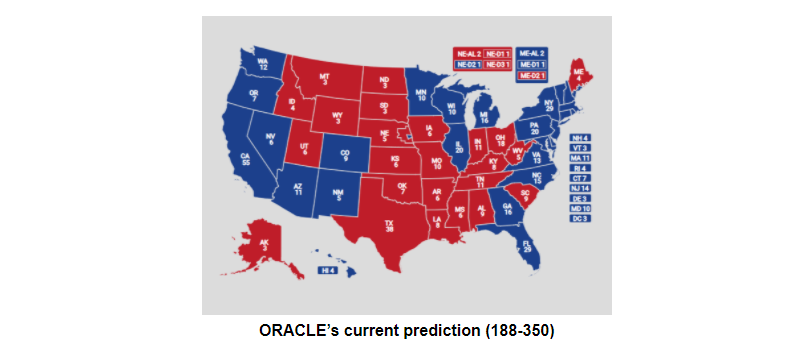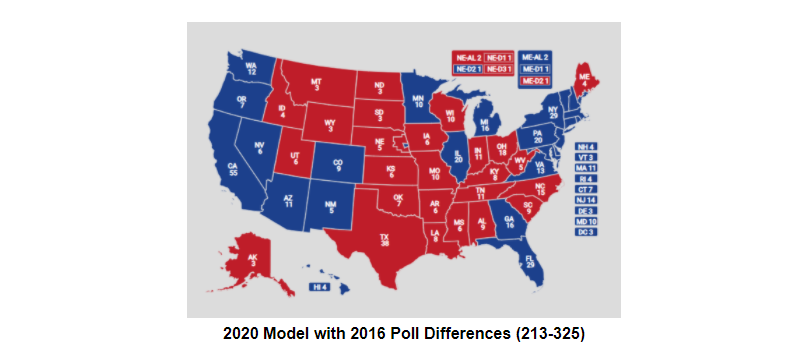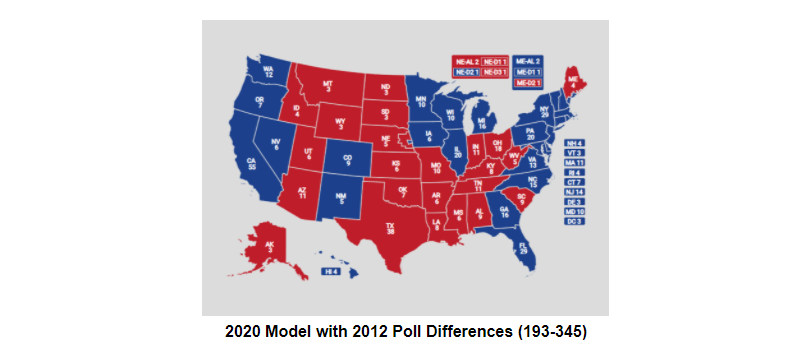But What About 2016? An Analysis of Polling Error
Introduction
In 2016, the majority of polls pointed to the Democratic nominee, Hillary Clinton, winning the presidency and becoming the first female president of the United States. However, this was not the case. In many 2016 models, statisticians (including us) failed to account for variables such as the impact that a college education has on voting. This oversight resulted in a false sense of confidence for many voters across the country as Donald Trump ended up beating Hillary Clinton by 77 electoral votes.
To combat the same confusion this election, we have decided to model the outcome of swing states with the same difference between the polls and the election results in both 2012 and 2016. We hope to clarify what the results of this election will be if the polls are as inaccurate as they were in past elections.

Methodology
To begin this process, we collected both the polling data and the election results from 9 consistent swing states in the 2012 and 2016 presidential elections. We calculated the difference between the Republican percentage of vote predicted by the polls and the actual Republican vote percentage in the corresponding election by subtracting the polling result from the actual result. **note we used two party vote percentages for all calculations** Following this, we applied those differences to the current 2020 polling data to see if an error, like the one in the 2016 polls, would shift our model’s current predictions.
Analysis
New Hampshire Currently, polls in New Hampshire show 45.2% of voters supporting Donald Trump. After applying the 2012 polling difference, the percentage of voters that support Trump would decrease to 43.5%. On the other end of the spectrum, applying the 2016 polling difference would increase the percentage of voters supporting Donald Trump to 45.4%. Neither applications of these differences would affect the popular vote of this state, as the Democratic nominee would still hold the majority of voters. --New Hampshire has voted for the Democratic nominee since 2004. As they are the first state primary, candidates often target appearances there and meet voters. The state is fairly even in its party registration, close to an equal 33%-33%-33%. Drug abuse is an important issue to voters in this state. --
Michigan 2020 polling data shows 46.9% of voters supporting Donald Trump. After applying the 2012 polling difference, the percentage shifts down to 44.2% in favor of Trump. However, with the application of the 2016 polling difference, the number increases to 49% of voters in favor of Trump. Even with the increase from the 2016 polling difference, Biden still takes the majority of voters in the state. --Michigan voted to elect Trump in 2016, however, the margin was the smallest of any state, coming down to a 0.3% difference. The state elected Obama in both 2008 and 2012. The state doesn’t require individuals to affiliate with a party when they register to vote, so there is no statistic on the number of Democrats to Republicans. --
Florida Florida’s 2020 polls predict 49.1% of voters supporting Donald Trump. Applying the 2012 polling difference brings that percentage down to 47.9%, but applying the 2016 polling difference brings it up to 49.6%. Although close, the applied 2016 difference still puts Democratic nominee Joe Biden leading Florida. --Florida’s demographics have made it an important swing state in recent years, the partisanship is clearly reflected in their State House representatives (13 Democrats and 14 Republicans). The people of Florida tend to prioritize the key issues associated with their affiliated party. Gun control has been a point of contention in recent years following the mass shooting at Marjory Stoneman Douglas High School in February 2018. The state of Florida has 29 electoral votes.--
Iowa Current polls in Iowa show 50.5% of voters supporting Donald Trump. Applying the 2012 polling difference brings this number down to 48.8%, but applying the 2016 polling difference raises the percent to 53.9%. Applying the 2012 difference to current 2020 polls would flip the state of Iowa to favor Democratic nominee Joe Biden, however, applying the 2016 polling data pushes the state to voting more Republican. --Iowa is a swing state with almost equal registered Democrat and Republican voters. The state has 36% registered third party/independent voters, an unconventionally large number. Politicians frequent Iowa as it’s the first state to hold its caucus. Current hot button issues are tax cuts and workforce training. --
Wisconsin 2020 polls in Wisconsin have 46.6% of voters supporting Donald Trump. Applying the 2012 polling difference raises this number to 48.9%, and applying 2016 polling differences brings the number to 50.7%, which would flip the state in favor of Donald Trump .--In the last few elections, Wisconsin has voted to elect the Democratic nominee, but recent polls show the possibility that Wisconsin votes more to the right. Wisconsin's voters are divided, 42% Democrat and 42% Republican. Similarly, Wisconsin's Congressional makeup is split among 4 Democrats and 6 Republicans. Key political issues include healthcare, education reform, and iron mining regulations.
North Carolina North Carolina’s 2020 polls show 49.3% of voters supporting Donald Trump. When applying the 2012 polling difference, this number decreases to 48.7% in favor of Trump. Applying the 2016 polling difference raises the percentage to 50.7%, which flips the state of North Carolina to favor Donald Trump. --North Carolina has become a state to watch this election despite the Republican party’s consistent history both in the legislature and presidential electoral results. With increasing populations of college students, non-white voters, and college educated residents, the state has become more moderate. However, North Carolina is also home to over 2 million unaffiliated voters that have the power to swing the state.--
Arizona Currently, polls in Arizona show 49.4% of voters supporting Donald Trump. Application of the 2012 polling differences puts Arizona at 50.2%, flipping the state in favor of the Republicans. Applying the 2016 polling difference puts the percentage at 49% of voters supporting Donald Trump. --Arizona has voted for the Repubilcan nominee in each general election since 2000. The state is 32.41% registered Democrats, 34.84% registered Republicans, and 32.7% registered other parties. Current issues that are important to voters are the COVID-19 pandemic and immigration. --
Pennsylvania Pennsylvania’s 2020 polls show 47.2% of voters supporting Donald Trump. Applying the 2012 polling difference brings this number down to 45.4%, still in favor of the Democrats. The application of the 2016 polling difference to current polls also drops the percentage down to 46.6%. --Pennsylvania is a heated battleground state, with 20 electoral votes and the potential to swing the results of the election. The state has 47.5% registered Democrats, 38.2% registered Republicans, and 14% registered Independents. In 2016 the state went red for Trump, but current polls show Biden leading the state by a small margin. --
Ohio Current polls in Ohio show 50.8% of voters supporting Donald Trump, which actually doesn't shift when the 2012 polling difference is applied (stays at 50.8%). However, when applying the 2016 polling difference, the number increases to 53.2% of voters supporting Donald Trump. --Ohio elected Trump in 2016 but Obama in both 2008 and 2012. The state has a mixed voting history, with 40% registered Democrats, 42% registered Republicans, and 18% registered Independent. Important issues in Ohio include abortion and second amendment rights.--
Conclusion
 With the application of the 2016 polling differences to current 2020 polls, only two states would flip. Wisconsin, with 10 electoral votes, would flip to favor Republican incumbent Donald Trump. North Carolina, with 15 electoral votes, would also flip to favor Republican incumbent Donald Trump. While this raises Trump’s predicted electoral count from 188 to 213, Democratic nominee Joe Biden would still win the majority of electoral votes (325), and therefore the predicted outcome of the election will stay the same (in favor of Democratic nominee Joe Biden).
With the application of the 2016 polling differences to current 2020 polls, only two states would flip. Wisconsin, with 10 electoral votes, would flip to favor Republican incumbent Donald Trump. North Carolina, with 15 electoral votes, would also flip to favor Republican incumbent Donald Trump. While this raises Trump’s predicted electoral count from 188 to 213, Democratic nominee Joe Biden would still win the majority of electoral votes (325), and therefore the predicted outcome of the election will stay the same (in favor of Democratic nominee Joe Biden).
 With the application of the 2012 polling differences to current 2020 polls in each of our studied swing states, again only two states would flip. Iowa, with 6 electoral votes, would flip to favor Democratic nominee Joe Biden. Arizona, with 11 electoral votes, would flip to favor Republican incumbent Donald Trump. Even with these applied differences, the predicted outcome of the election will stay the same, in favor of Democratic nominee Joe Biden with a total electoral count of 193--345.
With the application of the 2012 polling differences to current 2020 polls in each of our studied swing states, again only two states would flip. Iowa, with 6 electoral votes, would flip to favor Democratic nominee Joe Biden. Arizona, with 11 electoral votes, would flip to favor Republican incumbent Donald Trump. Even with these applied differences, the predicted outcome of the election will stay the same, in favor of Democratic nominee Joe Biden with a total electoral count of 193--345.
